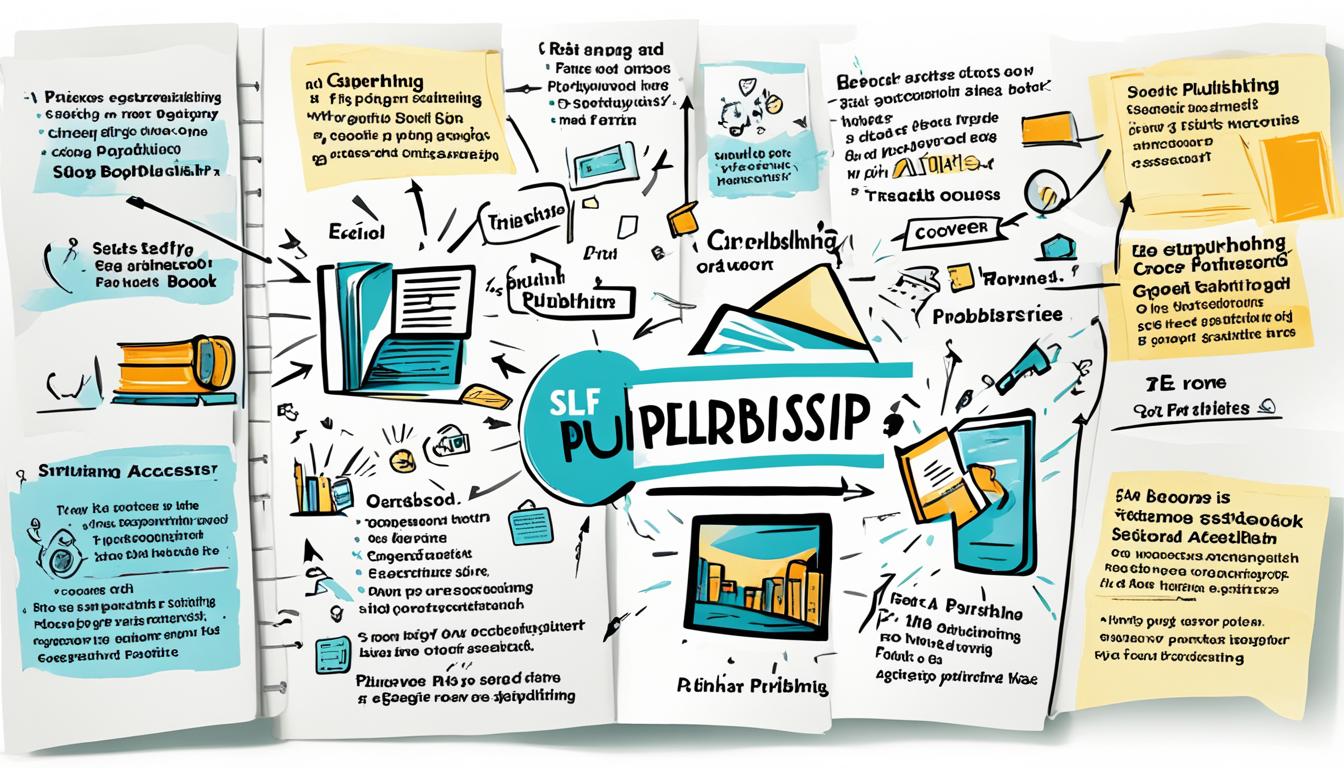Do you have a manuscript that you’ve been itching to publish? If you’re based in Canada, you may be wondering about the process and cost of publishing a book in the country. From finding the right publishing company to navigating the various steps involved, there are several factors to consider. But fear not! In this complete guide, we will walk you through the ins and outs of publishing a book in Canada. Whether you’re a first-time author or an experienced writer looking for new opportunities, this article will provide you with all the information you need to bring your book to life. So, let’s dive in and explore how to publish a book in Canada, the various book publishing companies in the country, and the typical costs associated with this process.
Understanding the Book Publishing Landscape in Canada
The Canadian publishing industry offers authors two primary paths to bring their books to market: traditional publishing and self-publishing. Each approach presents its own unique advantages and challenges for aspiring writers to consider.
Traditional Publishing vs Self-Publishing
Traditional publishing in Canada involves submitting your manuscript to literary agents and publishing houses, who then evaluate the work and decide whether to offer a contract. This can be a lengthy and competitive process, with many authors facing rejection before finding the right fit. In contrast, self-publishing empowers Canadian authors to maintain creative control and earn higher royalties, but also requires managing the entire publishing process independently.
Benefits of Self-Publishing
The key advantages of self-publishing in Canada include the absence of gatekeepers, the ability to retain a larger share of royalties, and greater control over the creative direction of your book. Additionally, self-published authors can achieve production values on par with traditional publishing, leveraging professional editing, cover design, and distribution services.
Challenges of Self-Publishing
While self-publishing offers greater autonomy, it also requires Canadian authors to handle a wide range of responsibilities, such as editing, cover design, formatting, distribution, and marketing. Navigating these tasks without the support of a publishing house can present significant challenges, particularly for first-time authors. Understanding the pros and cons of each publishing route is crucial for Canadian authors to determine the best path forward for their book.
Write a Marketable Book
Before diving into the self-publishing process, it’s crucial to ensure your book is marketable. This involves three key steps: identifying your genre, researching your target audience, and analyzing bestsellers in your genre.
1. Identify Your Genre
Knowing your book’s genre is essential for understanding the specific elements, structure, and style that appeal to your readers. Identifying your genre will help you craft your manuscript in a way that resonates with your target audience and aligns with industry standards.
2. Research Your Target Audience
Researching your target audience will provide valuable insights into what they look for in books and how they discover new titles. Understanding your readers’ preferences, habits, and pain points will enable you to tailor your marketing efforts and ensure your book meets their needs.
3. Analyze Bestsellers in Your Genre
Studying the bestselling books in your genre can reveal what’s working well and uncover opportunities to differentiate your book. Analyzing the cover design, book descriptions, reader reviews, and marketing strategies of successful titles can inspire your own approach and help you identify gaps in the market.

Exploring the market potential of your book before publishing will make it easier to sell your book and connect with the right readers. By following these steps, you can ensure your self-published work in Canada stands out and resonates with your target audience.
Edit Your Manuscript Professionally
Before publishing your book, it’s crucial to ensure it’s been professionally edited to the same high standards as traditionally published works. This process begins with self-editing your first draft, then seeking feedback from your target audience, and finally hiring a freelance editor to refine your manuscript.
1. Self-Editing Your First Draft
Taking the time to self-edit your initial draft allows you to improve the overall readability, cohesiveness, and flow of your manuscript. This includes reviewing for grammatical errors, tightening up language, and ensuring the narrative structure is compelling.
2. Getting Feedback from Your Audience
Gathering feedback from prospective readers, whether through beta reading groups or targeted surveys, can help identify areas that need improvement before sending your book to a professional editor. This outside perspective can uncover plot holes, character development issues, or sections that require further clarity.
3. Hiring a Freelance Editor
Once you’ve self-edited and incorporated audience feedback, the next step is to hire a freelance editor. Platforms like Reedsy, Upwork, Fiverr, and Guru connect self-publishing authors with experienced editors who can provide an outside perspective and expertise to refine your manuscript at the line-editing and copyediting stages. Investing in professional editing is crucial for ensuring your self-published book meets the same quality standards as traditionally published works.
Design an Attention-Grabbing Book Cover
Your book cover is the first impression readers will have of your work, so it needs to be eye-catching and aligned with your genre. Whether you hire a professional designer or design the cover yourself, you’ll need to understand the importance of covers, follow design best practices for your genre, and think in terms of how the cover will appear as a thumbnail online.
1. Understand the Importance of Book Covers
A well-designed book cover can make a significant difference in attracting potential readers and conveying the tone and content of your work. It’s crucial to create a cover that stands out in a crowded marketplace, communicates the genre and subject matter, and leaves a lasting impression on your audience.
2. Hire a Professional Designer or Design It Yourself
If you have the necessary design skills and software, you may choose to create your own book cover. However, hiring a professional designer can often lead to a more polished and visually appealing result. Freelance platforms like Reedsy, Upwork, Fiverr, and Guru can connect you with talented designers who specialize in book cover design and understand the unique requirements of the publishing industry.
3. Follow Design Best Practices for Your Genre
Studying successful book covers in your genre can provide valuable inspiration and insights into the design elements that resonate with your target audience. Pay attention to factors such as typography, imagery, color schemes, and overall composition to ensure your cover aligns with reader expectations and stands out on virtual and physical bookshelves.

How to Publish a Book in Canada?
When self-publishing a book in Canada, the first crucial step is to choose the right publishing platform. Some of the most popular options include Amazon’s Kindle Direct Publishing (KDP), Kobo Writing Life, and IngramSpark. These platforms provide self-publishing authors with the essential tools and distribution channels to publish their books as ebooks, paperbacks, or hardcovers.
1. Choose Your Self-Publishing Platform
Each self-publishing platform offers unique features and advantages. Amazon’s KDP is a widely used option, allowing authors to easily publish and sell their books on the Amazon marketplace. Kobo Writing Life caters specifically to the Canadian market, providing authors with the opportunity to reach readers across the country. IngramSpark, on the other hand, facilitates broader distribution, enabling authors to get their books stocked in brick-and-mortar bookstores across Canada and beyond. Carefully evaluating the pros and cons of each platform will help you determine the best fit for your self-publishing journey.
2. Format Your Book for Publishing
Once you’ve selected your self-publishing platform, the next step is to properly format your manuscript for publication. This involves adhering to industry standards for elements such as font, spacing, page layout, and more. Ensuring your book’s interior is professionally formatted is crucial for creating a polished and visually appealing final product.
3. Set Up Your Book Metadata
The final piece of the self-publishing puzzle is setting up your book’s metadata. This includes details like the title, subtitle, author name, book description, keywords, and International Standard Book Number (ISBN). Optimizing this metadata is essential for enhancing the discoverability of your book on online retailers and helping readers find your work.
By choosing the right self-publishing platform, properly formatting your book, and carefully setting up your metadata, you can ensure a successful self-publishing journey in the Canadian market.
Book Marketing and Promotion Strategies
Once your book is published, the work doesn’t stop there. Self-publishing authors in Canada need to focus on effective book marketing and promotion strategies to reach readers.
1. Build an Author Platform
Building a strong author platform is crucial for self-published authors in Canada. This includes creating a professional website, establishing an email list, and maintaining an active social media presence. Your author platform allows you to connect directly with your target audience, share updates about your work, and engage with readers.
2. Leverage Social Media
Social media platforms like Twitter, Instagram, and TikTok can be powerful tools for Canadian self-published authors to connect with readers and generate buzz about their books. Develop a consistent social media strategy, create engaging content, and leverage popular hashtags to reach new audiences and build a loyal following.
3. Explore Book Promotion Techniques
Beyond building your author platform and leveraging social media, there are various other book promotion techniques self-published authors in Canada can explore. This includes running giveaways, guest blogging on relevant websites, reaching out to book reviewers, and collaborating with other authors in your genre. A multi-faceted approach to book promotion can help increase your book’s visibility and drive sales.

A comprehensive marketing strategy is essential for self-published authors in Canada to stand out in the crowded book market. By building an author platform, leveraging social media, and exploring a variety of book promotion techniques, you can effectively connect with your target readers and drive the success of your self-published work.
Distribution and Sales Channels
Self-published authors in Canada have several distribution and sales channels to consider in order to reach their target audience effectively. Exploring and leveraging the various options available is crucial for achieving self-publishing success in the Canadian market.
1. Online Retailers and Marketplaces
Popular online platforms like Amazon, Kobo, and Apple Books provide self-published authors in Canada access to a vast customer base. These marketplaces offer comprehensive distribution, making it easy for readers to discover and purchase your book. By publishing on these platforms, you can ensure your book is readily available to a wide range of potential readers.
2. Brick-and-Mortar Bookstores
In addition to online sales, self-published authors in Canada can also explore partnerships with brick-and-mortar bookstores. Working with distribution partners like IngramSpark can help get your book stocked in physical bookstores, allowing readers to discover and purchase your work in-person. This can be particularly beneficial for building local awareness and fostering a connection with your community.
3. Direct Sales and Author Websites
Selling directly to readers through your own author website or at local events can also be a lucrative option for self-published authors in Canada. This approach allows you to keep a larger share of the profits and maintain a more direct relationship with your audience. By leveraging your author platform and promotional strategies, you can drive sales and connect with readers on a more personal level.
Legal and Financial Considerations
As self-publishing authors in Canada, there are several legal and financial aspects you’ll need to address to ensure a successful publishing journey. From obtaining the necessary International Standard Book Numbers (ISBNs) and barcodes to understanding copyright and licensing options, as well as determining the right pricing strategy and royalty structures, navigating these considerations is essential for your self-publishing venture.
1. Obtaining ISBNs and Barcodes
ISBNs are required for selling your book through major retailers, both online and in brick-and-mortar stores. In Canada, you can purchase ISBNs directly from Library and Archives Canada, which serves as the national ISBN agency. Barcodes, on the other hand, make your book easily scannable and are a crucial component for sales. Investing in these identifiers will ensure your book is readily available and accessible to readers across Canada.
2. Copyright and Licensing
Securing the copyright for your work is an important step in self-publishing. This grants you the exclusive legal rights to your original content and protects your intellectual property. Additionally, understanding licensing options, such as granting exclusive rights to certain platforms or retaining the ability to distribute your book through multiple channels, can help you maximize the reach and earning potential of your self-published work.
3. Pricing and Royalties
Determining the right pricing strategy for your book is crucial for achieving financial success as a self-published author in Canada. You’ll need to research pricing trends in your genre, consider production and marketing costs, and strike a balance between competitive pricing and maximizing your royalties. Understanding the varying royalty structures offered by different sales channels, such as online retailers and your own author website, will ensure you’re able to optimize your earnings from each book sale.

Continuing Your Writing Journey
Self-publishing a book in Canada is just the beginning of an author’s journey. To continue growing your readership and writing career, it’s important to build a cohesive author brand, connect with other authors in your genre, and plan for your next book.
1. Build an Author Brand
Developing a strong author website, social media presence, and consistent visual identity can help readers identify and engage with your work. By establishing a recognizable brand, you can strengthen your connection with your audience and maintain a professional, polished image in the Canadian literary landscape.
2. Connect with Other Authors
Networking with fellow Canadian authors, whether through online communities or local writing groups, can provide valuable support and collaboration opportunities. Sharing experiences, best practices, and industry insights can help you navigate the self-publishing journey and find new ways to grow your readership.
3. Plan for Your Next Book
Starting to plan your next book project while promoting your current one will keep your creative momentum going and expand your body of work. Continuously developing new ideas, refining your writing process, and building upon your existing audience can help you sustain a thriving self-publishing career in Canada.
Maintaining this continuous focus on professional development and growth is crucial for self-published authors in Canada. By embracing these strategies, you can further strengthen your writing journey and connect with a wider audience in the Canadian book market.
Resources and Tools for Self-Publishing Authors
Self-publishing in Canada requires the use of various resources and tools to streamline the process. From writing software and design programs to publishing platforms and freelance services, Canadian authors have access to a wealth of versatile options to support their self-publishing journey.
1. Writing Software and Tools
To enhance productivity and refine their craft, self-publishing authors can turn to writing software and tools like Scrivener, Google Docs, and ProWritingAid. These programs offer features such as project organization, advanced formatting, and real-time feedback to help authors polish their manuscripts before publication.
2. Book Design and Formatting Tools
Creating a professional-looking interior for a self-published book is essential, and tools like Vellum, Reedsy Book Editor, and Adobe InDesign can simplify the design and formatting process. These programs provide templates, layout options, and typesetting capabilities to ensure your book’s content is presented in a visually appealing and consistent manner.
3. Publishing Platforms and Services
When it’s time to publish, distribute, and sell your book, platforms like Amazon’s Kindle Direct Publishing, Kobo Writing Life, and IngramSpark offer the necessary infrastructure for both digital and print formats. Additionally, freelance services found on sites like Reedsy, Upwork, Fiverr, and Guru can connect self-publishing authors with editors, designers, and other professionals to support their publishing journey.
By leveraging these resources and tools, self-publishing authors in Canada can enhance their productivity, create a polished book, and navigate the publishing process with greater ease and efficiency.
Conclusion
Self-publishing in Canada has become a viable and attractive option for authors who want to maintain creative control, earn higher royalties, and bypass the traditional publishing gatekeepers. By understanding the publishing landscape, writing a marketable book, editing professionally, designing an eye-catching cover, navigating the publishing process, implementing effective marketing strategies, and addressing legal and financial considerations, Canadian authors can successfully self-publish and reach readers.
Additionally, continuously building an author brand, connecting with other writers, and planning for future projects will help sustain a thriving self-publishing career. With the abundance of resources and tools available, self-publishing presents an exciting opportunity for Canadian authors to share their stories and connect with audiences.
By following the comprehensive steps outlined in this guide, aspiring authors in Canada can embark on a rewarding self-publishing journey. The path to success may not be without its challenges, but the benefits of self-publishing make it a compelling option for those seeking to take control of their writing careers and reach readers on their own terms.
FAQ
1. How much does it cost to get a book published in Canada?
The cost to publish a book in Canada can vary significantly, depending on whether you choose traditional publishing or self-publishing. Traditional publishing often involves advances, royalties, and administrative fees, while self-publishing allows you to manage the costs of editing, cover design, formatting, and distribution yourself.
2. Can you self-publish a book in Canada?
Yes, self-publishing is a viable option for authors in Canada. Self-publishing platforms like Amazon’s Kindle Direct Publishing, Kobo Writing Life, and IngramSpark provide the tools and distribution channels to publish your book as an ebook and/or physical paperback or hardcover.
3. What is the average cost to publish a book?
The average cost to publish a book can range from a few hundred dollars for self-publishing to thousands of dollars for traditional publishing, depending on factors like editing, cover design, marketing, and distribution.
4. How do you publish a book for the first time?
For first-time authors, the self-publishing route often provides the most control and flexibility. The key steps include writing a marketable book, editing it professionally, designing an eye-catching cover, formatting the manuscript, publishing through a platform, and implementing effective marketing strategies.
5. How do you sell a book you wrote?
To sell a self-published book in Canada, you’ll need to focus on book marketing and promotion strategies, such as building an author platform, leveraging social media, engaging with book reviewers, and exploring distribution channels like online retailers, brick-and-mortar bookstores, and direct sales through your author website.
6. How much do first time authors make on a book?
The earnings for first-time authors can vary significantly, ranging from a few hundred dollars to potentially thousands or even millions, depending on factors like book sales, publisher royalties, and the author’s overall marketing and promotion efforts.




